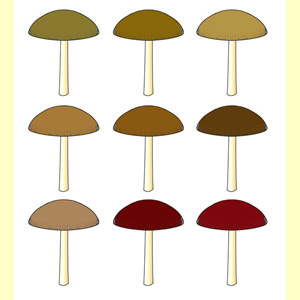
If the colour can best be described as a modification of one colour by another, you should usually choose the main colour. So, if the colour is reddish orange, choose orange, and if yellowish brown, choose brown. However, where there are tints of blue, green or purple, these states should be chosen.
Colour charts are referred to in capitals: BFF (Royal Botanic Gardens Edinburgh, 1969), METHUEN (Kornerup & Wanscher, 1978) and RAYNER (Rayner, 1970).
The same colour name can be applied to different colours in different colour charts (compare apricot in BFF and METHUEN). If a colour is on the border between two of the categories (such as the orange yellow colour apricot, or the blue green colour verdigris) choose both colours.
If the colour is best described as brown obviously modified with blue, green or purple, choose blue, green or purple.
The colour vinaceous (often used in descriptions of fungi, and see BFF and RAYNER) lies at the border of purple and brown, choose one or both options according to the predominant impression of the colour.
For very pale shades of brown, such as pale buff, choose pale.
